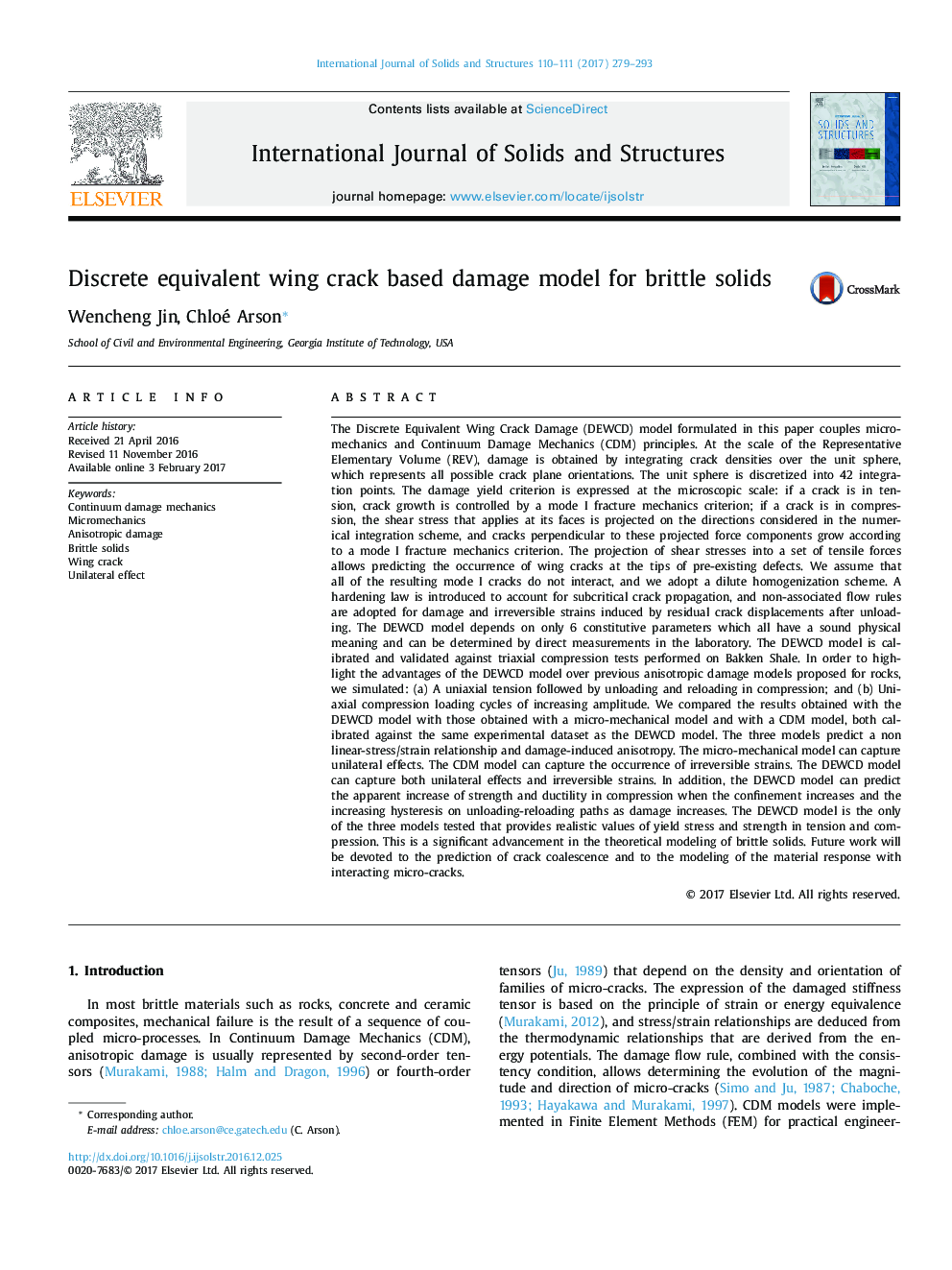| کد مقاله | کد نشریه | سال انتشار | مقاله انگلیسی | نسخه تمام متن |
|---|---|---|---|---|
| 4922514 | 1430189 | 2017 | 15 صفحه PDF | دانلود رایگان |
عنوان انگلیسی مقاله ISI
Discrete equivalent wing crack based damage model for brittle solids
ترجمه فارسی عنوان
مدل آسیب دیدگی بر مبنای معکوس گسسته برای جامدات شکننده
دانلود مقاله + سفارش ترجمه
دانلود مقاله ISI انگلیسی
رایگان برای ایرانیان
کلمات کلیدی
مکانیک آسیب مکانیکی، میکرومکانیک، آسیب ناحیه ای، جامدات شکننده کرک بال، اثر یک جانبه،
موضوعات مرتبط
مهندسی و علوم پایه
سایر رشته های مهندسی
مهندسی عمران و سازه
چکیده انگلیسی
The Discrete Equivalent Wing Crack Damage (DEWCD) model formulated in this paper couples micro-mechanics and Continuum Damage Mechanics (CDM) principles. At the scale of the Representative Elementary Volume (REV), damage is obtained by integrating crack densities over the unit sphere, which represents all possible crack plane orientations. The unit sphere is discretized into 42 integration points. The damage yield criterion is expressed at the microscopic scale: if a crack is in tension, crack growth is controlled by a mode I fracture mechanics criterion; if a crack is in compression, the shear stress that applies at its faces is projected on the directions considered in the numerical integration scheme, and cracks perpendicular to these projected force components grow according to a mode I fracture mechanics criterion. The projection of shear stresses into a set of tensile forces allows predicting the occurrence of wing cracks at the tips of pre-existing defects. We assume that all of the resulting mode I cracks do not interact, and we adopt a dilute homogenization scheme. A hardening law is introduced to account for subcritical crack propagation, and non-associated flow rules are adopted for damage and irreversible strains induced by residual crack displacements after unloading. The DEWCD model depends on only 6 constitutive parameters which all have a sound physical meaning and can be determined by direct measurements in the laboratory. The DEWCD model is calibrated and validated against triaxial compression tests performed on Bakken Shale. In order to highlight the advantages of the DEWCD model over previous anisotropic damage models proposed for rocks, we simulated: (a) A uniaxial tension followed by unloading and reloading in compression; and (b) Uniaxial compression loading cycles of increasing amplitude. We compared the results obtained with the DEWCD model with those obtained with a micro-mechanical model and with a CDM model, both calibrated against the same experimental dataset as the DEWCD model. The three models predict a non linear-stress/strain relationship and damage-induced anisotropy. The micro-mechanical model can capture unilateral effects. The CDM model can capture the occurrence of irreversible strains. The DEWCD model can capture both unilateral effects and irreversible strains. In addition, the DEWCD model can predict the apparent increase of strength and ductility in compression when the confinement increases and the increasing hysteresis on unloading-reloading paths as damage increases. The DEWCD model is the only of the three models tested that provides realistic values of yield stress and strength in tension and compression. This is a significant advancement in the theoretical modeling of brittle solids. Future work will be devoted to the prediction of crack coalescence and to the modeling of the material response with interacting micro-cracks.
ناشر
Database: Elsevier - ScienceDirect (ساینس دایرکت)
Journal: International Journal of Solids and Structures - Volumes 110â111, April 2017, Pages 279-293
Journal: International Journal of Solids and Structures - Volumes 110â111, April 2017, Pages 279-293
نویسندگان
Wencheng Jin, Chloé Arson,
